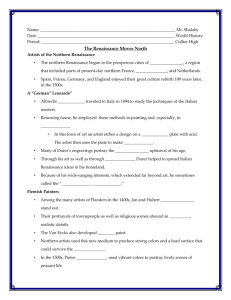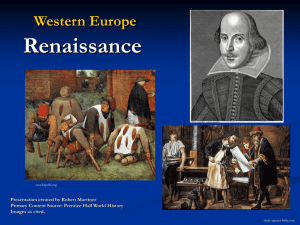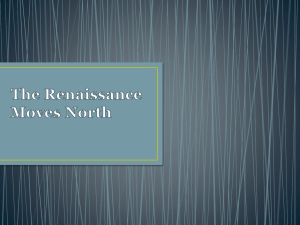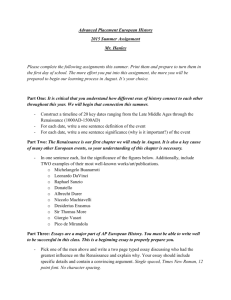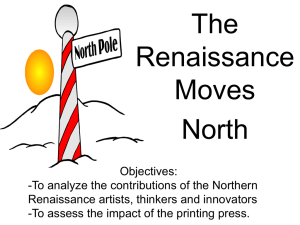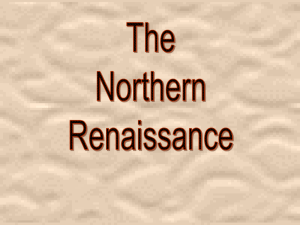The Northern Renaissance Reading
advertisement
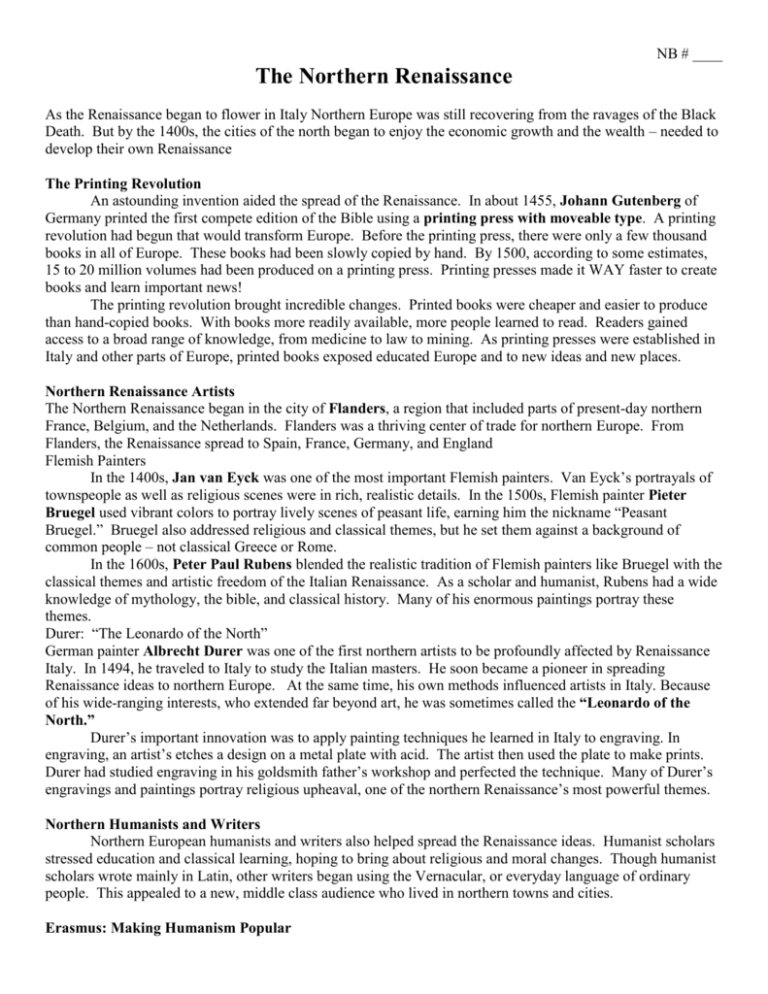
NB # ____ The Northern Renaissance As the Renaissance began to flower in Italy Northern Europe was still recovering from the ravages of the Black Death. But by the 1400s, the cities of the north began to enjoy the economic growth and the wealth – needed to develop their own Renaissance The Printing Revolution An astounding invention aided the spread of the Renaissance. In about 1455, Johann Gutenberg of Germany printed the first compete edition of the Bible using a printing press with moveable type. A printing revolution had begun that would transform Europe. Before the printing press, there were only a few thousand books in all of Europe. These books had been slowly copied by hand. By 1500, according to some estimates, 15 to 20 million volumes had been produced on a printing press. Printing presses made it WAY faster to create books and learn important news! The printing revolution brought incredible changes. Printed books were cheaper and easier to produce than hand-copied books. With books more readily available, more people learned to read. Readers gained access to a broad range of knowledge, from medicine to law to mining. As printing presses were established in Italy and other parts of Europe, printed books exposed educated Europe and to new ideas and new places. Northern Renaissance Artists The Northern Renaissance began in the city of Flanders, a region that included parts of present-day northern France, Belgium, and the Netherlands. Flanders was a thriving center of trade for northern Europe. From Flanders, the Renaissance spread to Spain, France, Germany, and England Flemish Painters In the 1400s, Jan van Eyck was one of the most important Flemish painters. Van Eyck’s portrayals of townspeople as well as religious scenes were in rich, realistic details. In the 1500s, Flemish painter Pieter Bruegel used vibrant colors to portray lively scenes of peasant life, earning him the nickname “Peasant Bruegel.” Bruegel also addressed religious and classical themes, but he set them against a background of common people – not classical Greece or Rome. In the 1600s, Peter Paul Rubens blended the realistic tradition of Flemish painters like Bruegel with the classical themes and artistic freedom of the Italian Renaissance. As a scholar and humanist, Rubens had a wide knowledge of mythology, the bible, and classical history. Many of his enormous paintings portray these themes. Durer: “The Leonardo of the North” German painter Albrecht Durer was one of the first northern artists to be profoundly affected by Renaissance Italy. In 1494, he traveled to Italy to study the Italian masters. He soon became a pioneer in spreading Renaissance ideas to northern Europe. At the same time, his own methods influenced artists in Italy. Because of his wide-ranging interests, who extended far beyond art, he was sometimes called the “Leonardo of the North.” Durer’s important innovation was to apply painting techniques he learned in Italy to engraving. In engraving, an artist’s etches a design on a metal plate with acid. The artist then used the plate to make prints. Durer had studied engraving in his goldsmith father’s workshop and perfected the technique. Many of Durer’s engravings and paintings portray religious upheaval, one of the northern Renaissance’s most powerful themes. Northern Humanists and Writers Northern European humanists and writers also helped spread the Renaissance ideas. Humanist scholars stressed education and classical learning, hoping to bring about religious and moral changes. Though humanist scholars wrote mainly in Latin, other writers began using the Vernacular, or everyday language of ordinary people. This appealed to a new, middle class audience who lived in northern towns and cities. Erasmus: Making Humanism Popular The Dutch priest and humanist Desiderius Erasmus, born in 1466, was one of the most important scholars of his age. He wrote texts on a number of subjects and used his knowledge of classical languages to produce a new Greek edition of the Bible. Erasmus helped spread Renaissance humanism to a wider public. He called for a translation of the Bible into the vernacular. He scorned those who “…don’t want the holy scriptures to be read in translation by the unlearned…as if the chief strength of the Christian religion lay in people’s ignorance of it…” To Erasmus, an individual’s chief duties were to be open-minded and to show good will towards others. As a priest, he was disturbed by the corruption of the Church and called for changes. Sir Thomas More’s Ideal Society Erasmus’s friend, the English humanist, Sir Thomas More, also preached for social reform. In Utopia, More describes an ideal society in which men and women live in peace and harmony. No one is lazy, all are educated, and justice is used to end crime rather than to eliminate the criminal. Today, the word utopia has come to describe any ideal society often with the implication that such a society is pretty much impossible to achieve. Rabelais’s Comic Masterpiece The French humanist Francois Rabelais had a varied career as a monk, physician, Greek scholar and author. In Gargantua and Pantagruel, he chronicles the adventures of two gentle giants. On the surface, the novel is a comic taile of travel and war. But Rabelais uses his characters to offer opinions on religion, education, and other serious subjects. Life More and Erasmus, Rabelais was deeply religious, but had doubts about the organized church. Shakespeare Writes for All Time The towering figure of northern Renaissance literature is the English poet and playwright William Shakespeare. Between 1590 and 1613, he wrote 37 plays that are still performed around the world today. His most famous plays include Romeo and Juliet, Macbeth, Hamlet, Taming of the Shrew, and Much ado about Nothing. Fellow playwright and poet Ben Jonson correctly predicted at the time that Shakespeare “…was not of an age, but for all time…” Shakespeare’s genius was in expressing themes in everyday, realistic settings. His work explores Renaissance ideals such as the complexity of the individual and the importance of the classics. At the same time, his characters speak in language that common people can understand and appreciate. Shakespeare’s love of words also vastly enriched the English language. More than 1,700 words appeared for the first time in his works.
